Queensland Aborigines and the Spanish Flu Pandemic 1918-19
By JOL Admin | 8 January 2019
This month marks 100 years since the start of the Spanish Flu pandemic in Australia - the first diagnosed case of Spanish Influenza occurred in Melbourne on the 9 January 1919. Earlier cases in late 1918 were mild and mis-diagnosed as lingering flu virus from the previous winter.
In 2014, following the Serving Country Forum held at the State Library, I put together the following blog post. It's quite timely to revisit this little known chapter of Australia's WW1 history.
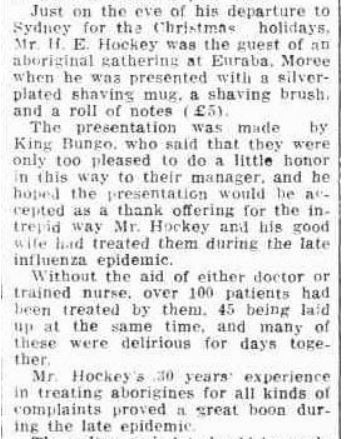
One of the interesting topics raised at the Serving Country Forum was the impact of the Spanish Flu on Aboriginal communities at the end of WW1. In my response to Jackie's keynote, I highlighted how 54 Aboriginal men, women and children died at Euraba Mission from the Spanish Flu in the nine months prior to an 'Aboriginal Welcome Home' for Charlie Bird and George Bennett. In the above newspaper article from December 1919, Euraba Station Manager Mr H E Hockey and his wife were thanked for their work in treating the people at the mission.
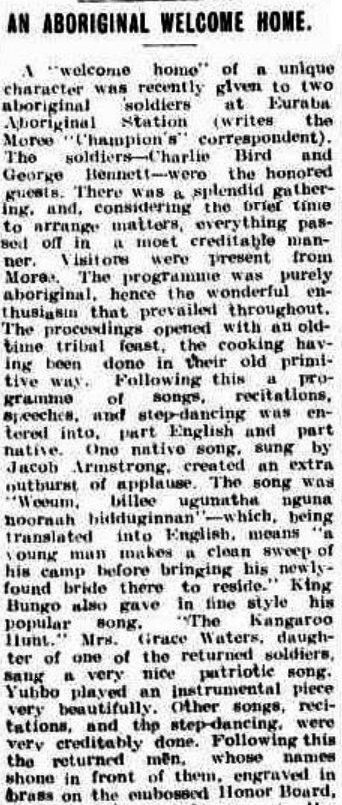
Euraba was an Aboriginal Station via Boomi near the Queensland-NSW border. Sometimes it is referred to as 'Old Toomelah' as the Aboriginal Mission was later moved to the present location of Toomelah, via Boggabilla. It was a small station comprising of about 100 Aboriginals from properties along the border including many originally from Queensland. The impact of 54 deaths in a small community would have been devastating. One of those who died was my Great Grandfather Jimmy Armstrong on the 13th July 1919; the following day his nephew Alec Armstrong also died from Spanish Flu.
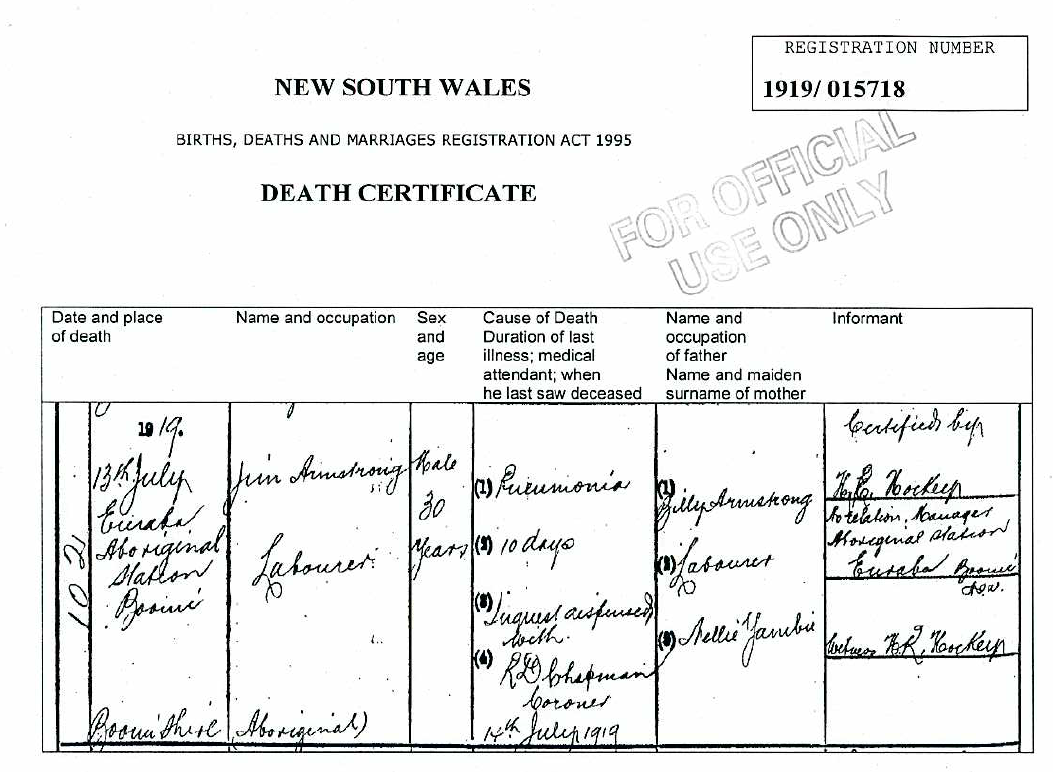
A panel later in the day at the Serving Country Forum also raised the topic and an audience member even suggested an alternative scenario to the Spanish Influenza. The 'Spanish Flu' was a series of pandemic waves emanating from Europe at the end of WW1. The disease reached Australia early in 1919 and it is believed was initially brought back to Australia by returning soldiers. The two waves in Australia during 1919 are believed to have claimed over 12,500 lives; the impact on Aboriginal communities was equally devastating.
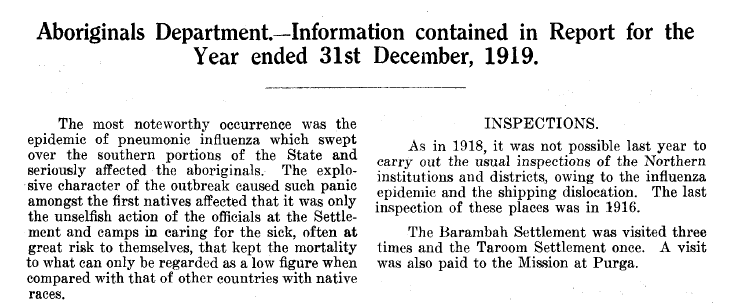
Gordon Briscoe as part of his doctoral thesis wrote a research paper entitled "Queensland Aborigines and the Spanish Influenza Pandemic of 1918-1919" which explored the impact on Queensland's Aboriginal communities. Briscoe's findings identified at least 30 percent of the Queensland death toll were known to be Aboriginals - this equates to ~315 people! The Chief Protector in his Annual Report for 1919, indicated that the unselfish actions of officials helped to keep 'the mortality to what can only be regarded as a low figure when compared with that of other countries with native races'.
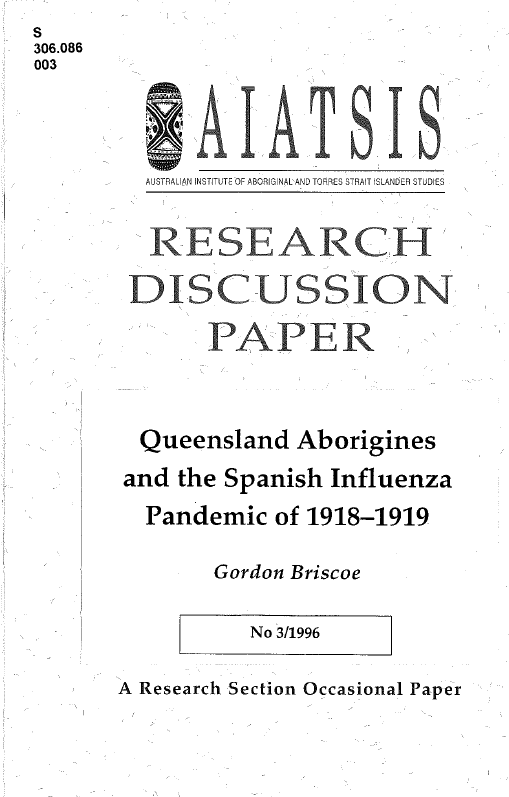
The Chief Protector of Aborigines Queensland, J W Bleakley, also highlighted the pandemic in his annual report of 1919, stating that Barambah was worst affected with 600 people contracting the disease with 87 deaths while Taroom had over 200 affected resulting in 31 deaths. It should be remembered that the Queensland Aboriginal missions were quite small in numbers; for example, Taroom in 1919 had approximately 400 residents, so over half of the community were infected with the disease! Mr C A Maxwell, the Superintendent at Taroom also succumbed to Spanish Flu.
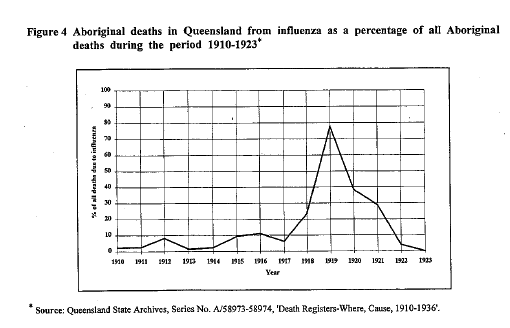
Aboriginal deaths in Queensland were formally recorded in 1910 and reported to the Chief Protector who then entered the information into the register. May-June 1919 was the second wave of the Spanish Flu pandemic and it was during this time frame that many Queensland Aboriginal deaths occurred. The majority of casualties were on the Aboriginal Missions or Depots with several deaths occurring on station camps or fringe town camps. The above table clearly shows the 'spike' in Spanish Flu deaths during 1919.
At this time, however, Aboriginal deaths due to respiratory and lung disease was already above the norm due to low immunity and poor health standards. Briscoe has attempted to separate this Spanish Flu data from pneumonia, consumption, TB, phthisis, etc. It wasn't until the 1919 pandemic that health legislation was amended to take into consideration the Spanish Flu.
This same legislation also gave 'local government councils, local hospital boards and general practitioners power over giving sick Aborigines access to the general hospitals and the waiving of the payment of fees'. There was no monitoring of this legislation as to whether they carried out their tasks and associated medical treatment with many Aboriginal people being sent to disease compounds which only exacerbated the impact of the disease. These disease compounds comprised basic huts enclosed by a 10-foot high cyclone fence, topped with barbed wire to prevent entry and escape!
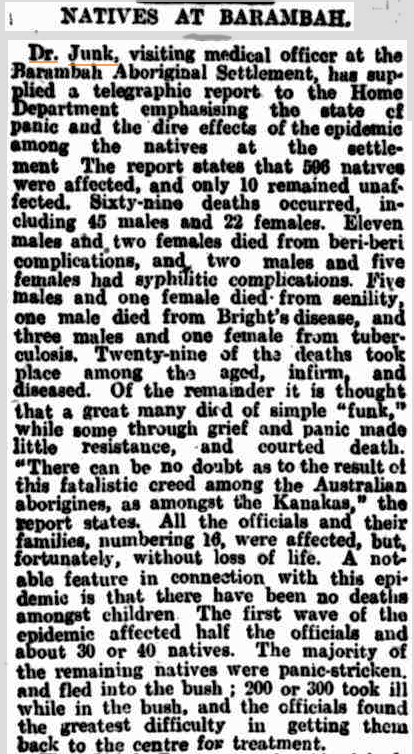
The above article appeared in The Queenslander on 14 June 1919 and refers to a report prepared by Dr David Junk, Visiting Medical Officer for Barambah Aboriginal Settlement to the Home Department. 'The report states that 596 natives were affected and only 10 remained unaffected'. Dr Junk went on to say that 'many died of simple 'funk', while some through grief and panic, made little resistance and courted death'.
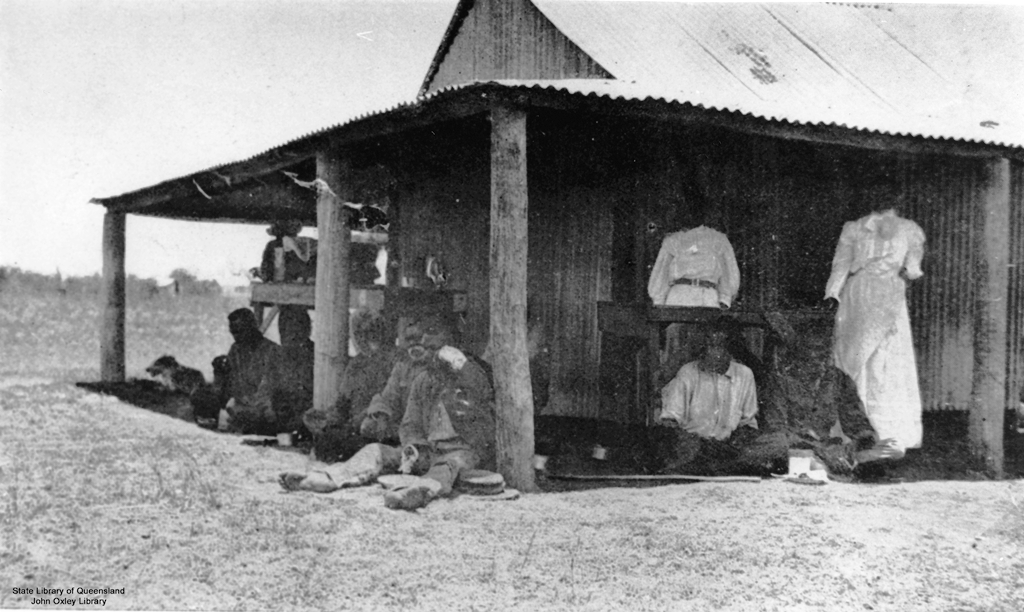
The above image from the State Library collection depicts the Barambah Hospital in 1911 when Dr David Junk from Wondai was appointed as the Visiting Medical Officer - his duties were 'to visit the settlement once per month and attend to emergencies'.
By the end of 1919, the Spanish Influenza pandemic had run its course within the mainstream Australian population, but still managed to linger in the Aboriginal community for another year or so, until immunity and resistance had built up. In response to the pandemic, the Chief Protector implemented reforms to provide better health care for Aboriginal communities and Depots. These included health clinics and professional health workers as well as the abolition of disease compounds; similar processes were also implemented into the primary health care services across Australia.
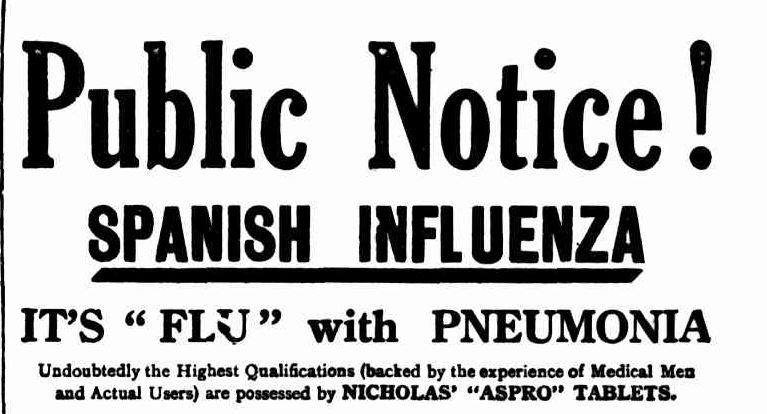
The Spanish Flu changed the way that Australian health authorities handled disease and quarantine. From the Western Front the disease infected soldiers from both sides, then the civilian populations of Europe before travelling back to England, America, South Africa and New Zealand before reaching Australian shores in January 1919. In response to outbreaks of the disease in southern States, the Queensland Government closed the borders and established Quarantine Camps at Coolangatta and Wallangarra. In 1921, the Australian Federal Government established the Commonwealth Department of Health as a means of coping better with such a national health issue.
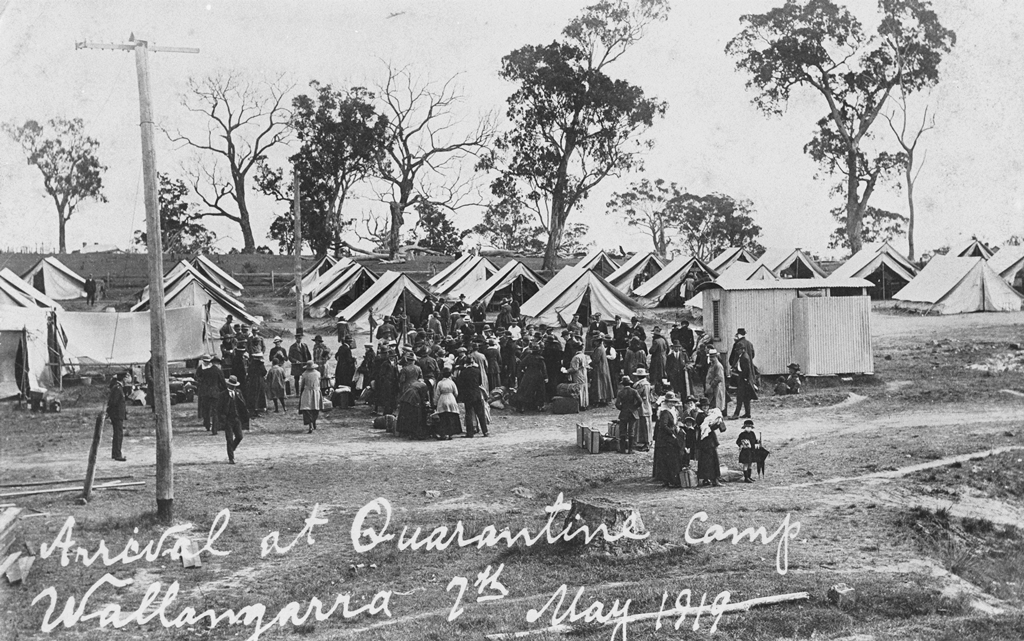
A tragic footnote is that WW1 had approximately 16 million casualties; however the Spanish Flu pandemic claimed an estimated 40-50 million lives!
Desmond Crump
Indigenous Languages Coordinator
State Library of Queensland Aboriginal and Torres Strait Islander Participation in WW1 webpages
References and Further Reading
Arrival at Quarantine Camp, Wallangarra 1919. JOL Negative 67478
Briscoe, G. (1996) Queensland Aborigines and the Spanish Influenza Pandemic of 1918-1919. S 306.086003
"Men and women outside building at Barambah Aboriginal Settlement 1911", JOL Negative 107840
Jim Armstrong, NSW Death Certificate 1919/015718 (NSW Registry of Births, Deaths and Marriages)
NSW Report of Board for Protection of Aborigines: AIATSIS Digitised Collections 'To remove and Protect'
State Library of Queensland JOL Blog: "SLQ and the Spanish Flu"
Trove/NLA Newspapers:
"An Aboriginal Welcome Home", The Richmond River Express and Casino Kyogle Advertiser, 5 September 1919.
"Presentation to Mr H E Hockey" Orange Leader, 31 December 1919.
"Natives at Barambah", The Queenslander, 14 June 1919.
"Spanish Flu in Queensland 1918-19" List
Comments
Your email address will not be published.
We welcome relevant, respectful comments.